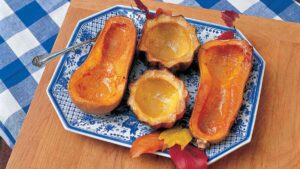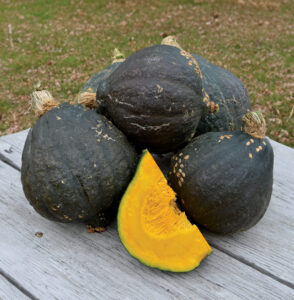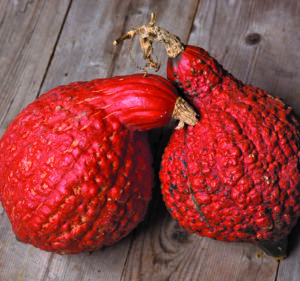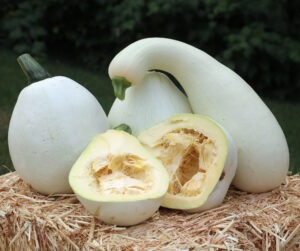Explore More
How to Store Winter Squash

How to Store Winter Squash
For some folks, harvest season brings hours and hours of canning, freezing, and drying to preserve crops for the colder months ahead. But if you’re looking for a crop that stores well all on its own, look no further than winter squash! Winter squash are versatile, nutritious, and can store for months.
Another bonus—you can still save seed from winter squash that has been in storage! In fact, for the best seeds, you should leave fruit of any squash to sit for at least three weeks before processing.
If you have winter squash growing in your garden or from a local market, these simple steps can help you prolong their shelf life.
If you’re interested in canning, freezing, or drying squash, keep reading! We’ll cover those methods as well.
When to Harvest Winter Squash
As winter squash reach maturity, their shell color will often deepen and either brighten up or take on a dull sheen. Harvest winter squash when the fruit has changed color and the stems are dry.
Harvest by cutting the squash from the vine, leaving at least three inches of the stem intact. Breaking squash off the stem at the base can cause decay in this area.

Harvest squash before your hard frost. If your squash has been exposed to a frost, use them as soon as possible. Squash will start decaying as soon as it thaws and might not last long after a freeze.
If you expect near-freezing temperatures (in the mid-30s) you might be able to keep winter squash safe with blankets. However, even when covering the squash, the frost could still cause damage that would affect the squash’s ability to store long-term. Squash exposed to freezing temperatures (32 degrees Fahrenheit and lower) may not survive, even with protection from blankets.
How to Cure Winter Squash
Right after harvest, winter squash are good to eat but their shell is still too soft for long-term storage. Curing winter squash toughens up the shell so that the squash can last in long-term storage.
To cure winter squash, bring the squash into a warm and sunny spot with good air circulation and leave for one to two weeks. Rotate the squash to expose all sides to the sun.

Note: Acorn squashes should not be cured in a warm spot and should be cooled right away after harvest.
Fingernail Test
Use a fingernail to test if the winter squash has been cured. Press a fingernail gently into the side of a squash. Squash that is ripe but not cured will bruise slightly and the skin may even break. If you cure the squash properly, the fingernail test should barely make a dent.
If you got the squash from the supermarket or another grower, use the fingernail test to determine if the squash has already cured.
How to Store Winter Squash
Move the squash to a cool and dry location (about 50 degrees Fahrenheit and 65% humidity). Basements, garages, and outbuildings all work well. Make sure the location gets good airflow.
Store the squash off the floor in a box or crate. Use straw and newspaper or paper towels to gently wrap the squash. This will keep the squash from touching one another and help absorb moisture.
While 50 degrees Fahrenheit is optimal, winter squash can still store well at warmer temperatures, even at room temperature. However, the warmer the temperature of storage is, the shorter the shelf life of the squash will be.
Don’t store winter squash at temperatures lower than 50 degrees, especially in a room that is not temperature controlled. When squash freezes, it will start decaying once it thaws. If your squash happens to freeze in storage, keep it frozen until you plan to use it.
When To Use Winter Squash
Inspect winter squash weekly for damage such as spots on the fruit or signs of shriveling. If you find damaged squash, use these first (and sooner rather than later). Turn squash gently to protect their skin and allow the air to circulate around the squash.
Sort winter squash by type to create a schedule of when to process and eat each one. Be sure to arrange your squash so you can get to your early varieties easily:
- Any damaged squash should be used as soon as possible.
- Delicatas, Acorns, and Buttercups should be used within a month or two.
- Hubbards, Pie squash, and pumpkins can last up to four months.
- Butternuts last the longest in storage and can take you right into spring.
Winter Squash Recipes
Winter squash can be pureed and sweetened as an addition to breads, muffins, cakes and pies. Diced and roasted squash can be tossed in warm salads of grains and nuts or with sautéed kale. Need some recipe ideas? Try these recipes from friends of Seed Savers Exchange!

Other Ways to Store Winter Squash
If you don’t have a good place to store winter squash, there are other options to keep your squash through the winter.
How to Freeze Winter Squash
Besides dry storage, freezing is the easiest way to store winter squash long-term. Frozen squash can keep for up to one year.
One option is to freeze your winter squash in cubes.
- Dice your squash, removing the ends and skin.
- Put the diced squash on a baking sheet in one layer and place in the freezer.
- Once the squash is frozen, place the cubes into freezer bags.
To help preserve the flavor, texture, and color, you can blanch your winter squash first before freezing it, but this is optional.
- Dice your squash, removing the ends and skin.
- Add cubed squash to a pot of boiling water for four to five minutes.
- Transfer the squash to a bowl of ice water immediately.
- Drain and freeze according to the instructions above.
The other option is to puree your winter squash. This option is great if you intend to use your squash in baking.
- Cut the squash in half and remove the seeds. (Don’t forget to save your squash seeds for next season!)
- Place the squash halves cut side down on a lined baking sheet.
- Bake at 400 degrees Fahrenheit for 30 to 45 minutes, until soft. Check the squash periodically. Squash with less flesh will not need to cook as long.
- Remove and allow the squash to cool.
- Puree the squash in a food processor and then add to freezer bags.
Canning Winter Squash
The only safe way to can winter squash is by canning cubed flesh in a pressure canner.
- Dice the squash into 1-inch cubes and boil in water for two minutes to kill bacteria. Do not mash or puree.
- Fill clean, warmed jars with the cubed squash and cooking liquid. Leave one inch of headspace.
- Squash are low-acid vegetables and must be pressure canned. Ball Mason Jars has a great guide.
Do not mash or puree the squash. Mashed/pureed squash is too dense and won’t allow proper heat penetration to the center of the jar. This can create conditions where harmful bacteria can thrive.
Winter Squash Pickles and Preserves
You can pickle winter squash to make into a variety of relishes, chutneys, and more. You cannot safely can pickled squash, as these products are not shelf-stable. Therefore, treat pickled squash as a fresh food and store in the refrigerator.
You can also use winter squash to make butters and spreads. Like pickled squash, you cannot safely can these products and must store them in the refrigerator.
Drying Winter Squash
Dried winter squash can last 6 to 12 months in storage and can be used in baking recipes, eaten as a snack, or added in soups.
- Cut the squash in half and remove the seeds.
- Slice the squash into thin, small strips, no more than one inch wide and ⅛ inch thick.
- Blanch the strips for two minutes, then submerge briefly in a bowl of ice water. Do not submerge long enough for the squash to return to room temperature. Drain and pat dry.
- Use a food dehydrator to dry the strips.
- Store dried strips in moisture-proof containers or bags. Check on the strips occasionally for mold.
Saving Winter Squash Seeds
Winter squash reaches seed maturity when the fruit is ripe for eating. This is great news for gardeners not wanting to miss out on eating the squash they save seed from! Let winter squash sit for at least three weeks before harvesting the seeds. You can harvest winter squash seeds at any point after this, even after months in storage, provided the squash is still in good condition!

To learn how to save squash seeds, check out our step-by-step growing and seed saving guide for squash. You can also apply these steps to other squash types, such as summer squash and gourds.
Recommended Winter Squash Varieties
Acorn Squash
These small squash are usually dark green/orange in color and have a slightly sweet, nutty flavor. Acorn squash will last 1 to 2 months in dry storage.
‘Gill’s Golden Pippin’ Squash
This flavorful acorn squash may be among the first to show up on your table each fall. Gill Brothers introduced the variety in 1952.
The fruits of this historic variety produce flesh that is pale orange, moderately sweet in flavor, and a bit variable in shape. Its vining plants are quite productive and yield relatively early-maturing fruits that measure 4-5 inches long and 3 ½ – 4 inches wide, and weigh 1-1 ½ pounds.
‘Table Queen’ Squash
(aka Des Moines, Danish) This variety set the standard for Acorn squash and started the rage for small individual fall squashes. It was introduced by the Iowa Seed Company of Des Moines, Iowa in 1913.
Its petite (1 pound), furrowed, soft shelled, high quality fruits have sweet orange flesh and are excellent for baking.
Delicata Squash
Delicata squash (also known as sweet potato squash) have mildly sweet and creamy skin, similar to a sweet potato. Delicata squash also do not need to be cured after harvest.
‘Honey Boat Delicata’ Squash
This gold-orange, green-striped delicata squash variety has an irresistibly sweet, nutty flavor, and stores well. Its vines reach up to 6 feet, while the fruits measure 6 to 8 inches in length and 3 inches in diameter and weigh up to a pound.
Bred by Dr. James Baggett at Oregon State University, ‘Honey Boat’ was introduced in 1990 and has proved popular among squash lovers in the years since.
Buttercup Squash
Buttercup squash are sweeter than most other winter squash with a very hard and inedible rind. They are medium keepers and can last one to two months in dry storage.
‘Burgess Buttercup’ Squash
This variety was introduced in 1952 by Burgess Seed & Plant Co. and is a bush version of the original Buttercup variety introduced in 1931.
Its fruits are flattened dark green turbans with a distinctive button on the blossom end, and typically weigh 3-5 pounds. It has super sweet, brilliant orange flesh with very fine eating qualities. The rind is thin but very hard.
Hubbard Squash
Hubbard squash are large with tough skin, and therefore store very well, lasting up to four months. They can work in any squash recipe.
‘Anna Swartz Hubbard’ Squash
This variety was given to Seed Savers Exchange by Anna Swartz of Pennsylvania who originally received it 40 years earlier in the 1950s. Anna loved this variety because of its extremely hard shell and excellent storage ability.
Its high quality flesh is the color of a sweet potato with similar flavor. Fruits weigh 5-8 pounds.
‘Golden Hubbard’ Squash
This squash was introduced by D. M. Ferry in 1898 but attributed to J.J. Harrison of Storrs & Harrison Co. of Painesville, Ohio.
It has a starchy, nutty, fine-grained flesh—good for baking and roasting. Fruits are 8-12 pounds and store well. An all-time American favorite.
Pie Squash
Pie pumpkin squash are smaller and sweeter than their larger and stringier pumpkin squash counterparts that are usually used for carving Jack-o-lanterns. Of course, they are excellent in pies but can also be used in other baked goods such as breads and in soups. They are medium keepers and, depending on the variety, can last up to four months.
‘Winter Luxury’ Squash
Also known as Livingston’s Pie Squash, this variety was Introduced in 1893 by Johnson & Stokes of Philadelphia. Amy Goldman, author of The Compleat Squash, says it is “the finest pie stock in the land.”
Its fruits average 6 pounds, making them the perfect size for two pies. The orange rind is covered in delicate netting; flesh is smooth, sweet, and fiber-free. It’s not the best keeper, so enjoy it for Thanksgiving or early winter.
‘Fortna White Pumpkin’ Squash
This variety’s large, pear-shaped fruit have variably-sized necks and cream-colored skin with light green stripes. Its pale-orange flesh has a memorable, mild, and slightly sweet flavor ideal for making pumpkin pies and many other sweet and savory dishes. The highly vining, productive plants bear pumpkins that weigh from 5-8 pounds.
Seed Savers Exchange received this variety from the Landis Valley Village and Farm Museum in Lancaster, Pennsylvania. It was grown by Wayne Fortna of Gettysburg, Pennsylvania, from the 1940s until his passing in 1990. Wayne tended this variety with particular care, ensuring there would always be a white pumpkin pie for Thanksgiving.
Pumpkins
‘Big Max Pumpkin’ Squash – New for 2025!
These huge, easy-to-grow pumpkins can tip the scales at well over 100 pounds while retaining a uniform, round shape ideal for carving spectacular jack-o’-lanterns.
Very thick, yellow-orange flesh makes delicious pumpkin pies and soup purée, unlike most other varieties of large pumpkins that are less suited for culinary use; and, yes, there’s plenty of it for canning or freezing, too!
‘Musquee de Provence’ Squash
Also known as Potiron Bronze de Montlhéry, this historic cheese pumpkin from the South of France was available in the U.S. as early as 1895 from Vaughan’s Seed Store in Chicago.
This gorgeous squash weighs up to 20 pounds and looks like wheels of cheese. Its deep orange flesh is dense and of superb table quality, ripening from green to burnt sienna. This variety is intolerant of cold, but has a very long shelf life.
Butternut Squash
Butternut squash is the sweetest type of winter squash, and lasts the longest in storage (up to six months). This is one of the most popular kinds of squash for baking.
‘Waltham Butternut’ Squash
This butternut, an All-American Selections winner in 1970, was the result of years of patient refinement and selection by Professor Robert Young of the Massachusetts Agricultural Experiment Station in Waltham.
This squash is prized for its straight necks, rich dry yellow-orange flesh, nutty flavor, and high-yielding vines. Its fruits are 3-6 pounds and are exceptional keepers.










